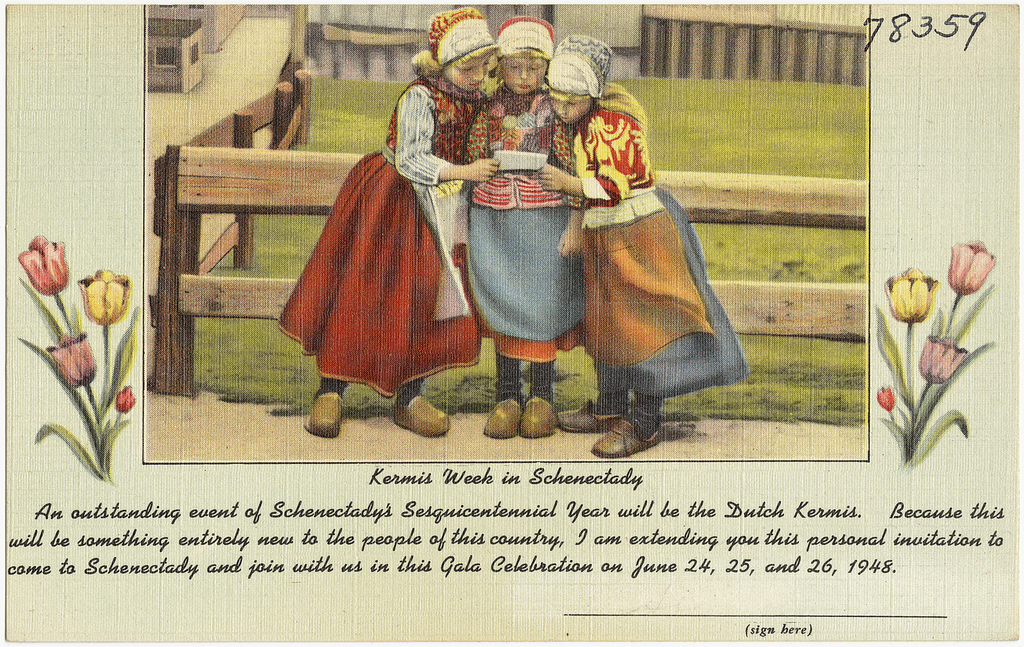
This postcard from the great Tichnor Collection posted by the Boston Public Library on Flickr raises the interesting question: What’s a Kermis?
Well, the Altamont Enterprise of June 18, 1948 is very glad you asked:
Schenectady, founded by Arent Van Curler and a party of 15 Holland Dutchmen in 1662, is going to be given back to the Dutch for a three-day period the last week in June [1948] when the first Dutch Kermis ever to be held in this country will be staged with all the fanfare and atmosphere which tend to make these festivals among the gayest events of the year in the Netherlands.
Schenectady was not chartered until 1798 and the Kermis will highlight the many events to mark the city’s sesquicentennial being celebrated this year. To whet the appetites of Schenectadians for what to expect at the coming kermis, a real Dutch dinner was held as the inaugural event of the sesquicentennial on March 29. The menu was strictly Dutch, having been provided by the chef of the Niew Amsterdam of the Holland-American line. The main course was Leidsche Hotspot met Klapstuk, which according to the chef was nothing more than “Leiden Hodge Podge” with boiled beef. Actually hodge podge was a mixture of potatoes and carrots. What proved a real treat to the 400 unacquainted with Dutch meals was the Griesmeel pudding met bessen sap, which was served just before the dessert of Dutch cheese and Holland rusk. Not until the meal was over did they learn it was just a Dutch way of preparing cream of wheat pudding with red currant sauce.
The Kermis in Holland originated as a mass said on the anniversary of the founding of a church. In honor of the patron saint it was first known as a Kirmass. Such celebrations, in early years quite religious with church bells ringing throughout the town ot mark its opening, gradually assumed a festive air. First the church allowed feasting, then dancing and some sports, until today it has assumed the air of a gay carnival. They now last a week and scarcely anyone works; all join in seven days of gaiety and fun making. The hot dog stands, as we know them in America, serve “poffertjes,” little round pancake blobs of dough twisted and covered with butter and sugar, and “wafelens,” which are oblong wafers, also buttered and sugared. Both come hot off the griddle. Fish booths offer herring and the more aristocratic smoked eel. This is the merry-go-round, roundabout swings for the children and many other county fair attractions.
Schenectady’s Kermis will officially get under way on June 24 with a mammoth street parade of Dutch floats and hundreds of children and adults all dressed in costumes of the Netherlands. Carrying out the Holland tradition, in the forefront of this parade will be the “Geldersche Achterhoek” or Kermis pole with a stork’s nest on top on which will be mounted a stuffed bird. As this reaches the Kermis grounds, amid the tolling every church bell in the city, it will be erected as a signal for the official opening of festivities. Present at this ceremony will be Dr. Eelco van Kleffens, Netherlands ambassador to this country, and Dr. Willem Cnoop Koopmans, consul general, from New York, both of whom have accepted invitations from Schenectady’s Mayor Owen Begley to come to America’s first Kermis. At the close of the Kermis, the pole will be taken down, carried in solemn funeral procession to its “burial” spot to repose until another year.
Tomorrow: probably more about Kermis!

Leave a Reply